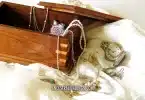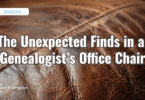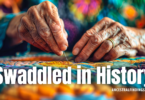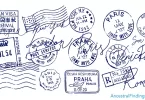Scrapbooking has been a popular hobby since the late 1800’s early 1900s in America. Your ancestor may have kept one. While it was typically a woman’s hobby, a good number of men did it, too, especially when it came to recording things that were important to them personally. Women were more likely to include things that were important to the family as well as themselves in their scrapbooks. Just like we do today, early scrapbooking enthusiasts put newspaper clippings, photographs, programs from important events, greeting cards, and other paper paraphernalia in their scrapbooks. Unlike the careful, acid-free scrapbooking that goes on today, scrapbooks of old were usually made using glue, tape, or other available adhesives. This means very old ones must be handled carefully.
For example, my great-uncle kept a scrapbook of newspaper clippings mentioning his high school football exploits and triumphs in the 1920s. I found it in his house when the family was cleaning it up after he died. I’d never seen a scrapbook so old at that point. It was kept in an old paper binder, with the ancient and yellowing newspaper clippings cut out of the papers they originated in and glued to sheets of paper. Sometimes, many clippings would be included on one page, while other pages only had one large clipping or the clipping of one article that was divided between more than one page in the newspaper. It was very fragile, with bits of both backing paper and newspaper flaking off when I touched it. I carefully removed the pages from the binder once I got it home.
I couldn’t un-glue the clippings, but I put all of the pages in acid-free sheet protectors to keep them from deteriorating further, and then put all the protected pages in a modern three-ring plastic binder with a title sheet printed out and placed in the plastic sleeve on the front of the binder. Before putting the protected sheets into the binder, I scanned them in their plastic sleeves, so I had an electronic record of the scrapbook in case anything happened to the delicate original.
Did your ancestor keep a scrapbook? You might check your local historical society or archives to see if one was donated to them. You can also ask around the various branches of your family to see if anyone inherited ancient scrapbooks. Don’t discount asking elderly relatives if they have any scrapbooks they kept in their youth, either. You might be surprised at what you find.
A scrapbook will tell you what was important to your ancestor and make them into a more three-dimensional, real person to you. The contents of the scrapbook may also reveal details about the family you never previously knew, including names of ancestors that may get you over that brick wall all genealogists eventually come up against. Look for scrapbooks starting around the 1860s and forward in time. The older, the better, as the more likely they will be to contain previously unknown information. No matter how old or young the scrapbooks are, though, preserve them and record their contents if they come into your possession, or scan them if you just get a chance to borrow them. The contents are important to your family history and to future generations of your family.






